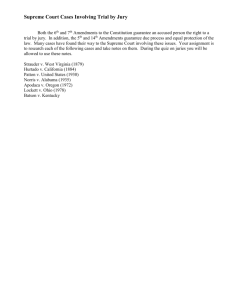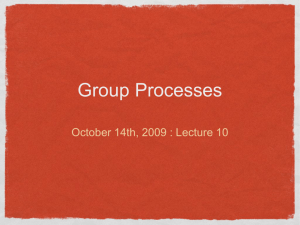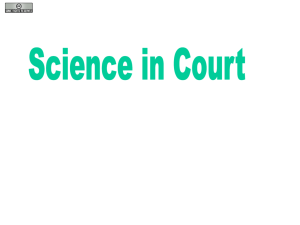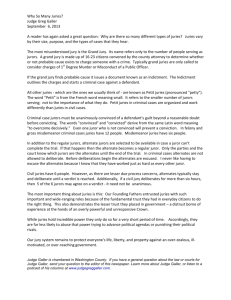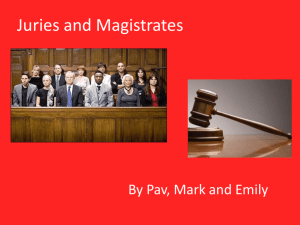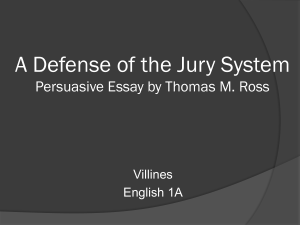Edwards_Juries
advertisement
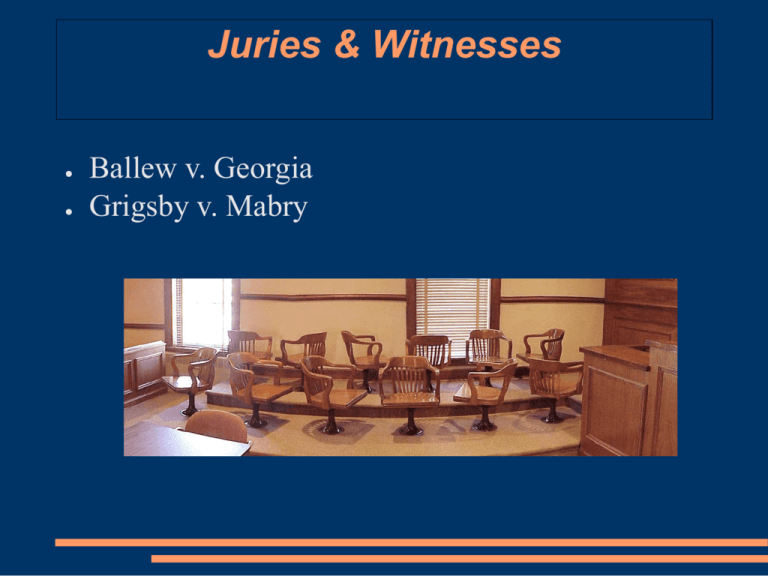
Juries & Witnesses ● ● Ballew v. Georgia Grigsby v. Mabry Ballew: Does Size Matter? ● ● Ballew is convicted of distributing obscene materials by a 5-member jury in Georgia state court Argues that his 6th Amendment rights were violated Law ● ● ● ● 14th Amendment – “No State shall make or enforce any law which shall abridge the privileges or immunities of citizens of the United States” 6th Amendment – “right to a speedy and public trial, by an impartial jury” Duncan v. Louisiana, 391 U.S. 145 (1968) – “the Fourteenth Amendment guarantees a right to trial by jury in all criminal cases that – were they to be tried in a federal court – would come within the Sixth Amendment's guarantee” Williams v. Florida, 399 US 78 (1970) – a 6-person jury is constitutional – “the purpose of the trial by jury is to protect against oppression by the Government” – 6th amendment requires a jury of sufficient size to promote group deliberation, insulate members from outside intimidation, and provide a fair possibility of obtaining a representative cross-section of the community – based on “convincing empirical evidence” that 6-person juries did not result in different outcomes from 12-person juries Findings in Ballew ● ● ● Issue: does a further reduction in size below 6 have an adverse effect, and if so, are there countervailing state considerations? Court finds that smaller juries: – are less likely to foster effective group deliberation (Lempert) – produce less accurate results. Type I error raises as jury size diminishes, Type II error raises as jury size increases. An optimal size can be reached based on this interaction (Nagel and Neef) – produce more varied verdicts, and variance amounts to an imbalance against the defense (Lempert and Zeisel) – are less representative of minority groups, and hence less likely to represent a cross-section of the community (Lempert/Asch) – could only disagree in 14% of cases anyway since judicial system handles so many “clear cases,”, so empirical research is biased towards consistency (Lempert) The court basically invalidated all present and future research on the subject and proceeded based on statistical inferences Zeisel and Diamond ● ● Criticized the 4 studies relied upon in Williams Washington study – – – – studied 128 workmen's comp. trials civil trials in Washington are tried before 6-member juries, unless 12-member juries are requested the opposite of random there are most probably definite reasons why attorneys request 12-person juries, though these are not mentioned, so the study is unreliable Zeisel and Diamond cont'd ● NJ study – same situation as Washington study, same difficulties – study mentions problem (unlike Washington), but essentially ignores it – study concluded that trials before 12-person juries took more time and awarded more damages than 6-person juries – but attorneys requested12-person juries for more complex cases involving more damages Zeisel and Diamond cont'd ● Michigan before-and-after study – – studied Michigan cases before and after they switched to 6-person juries suffered from historical effects ● ● – – a mediation board was created procedural rules were modified to allow discovery of insurance policy limits average award in auto negligence cases was $11,147 for 12-person juries and $23,768 for 6-person juries if the historical factors produced more settlements, this would have eliminated many low-damage cases, since these are more likely to settle than high-damage cases Zeisel and Diamond cont'd ● Michigan lab study – – – videotape of a trial shown to 8 6-person juries and 8 12-person juries comprised of undergraduates evidence weighted highly in favor of defendant instructed using Michigan jury instructions, which allow a 10-2 or 5-6 majority to return a verdict Lempert ● ● Critiqued Zeisel and Diamond's suggestions of how to do better studies Zeisel's ideal design – – – – have a jurisdiction in which cases were heard by both 6 and 12-member juries at the same time, and compare the results but this doesn't take into account the “clear cases” problem via statistical inference (648-53), only in 14.1% of cases does jury size have a reasonable probability of affecting jury verdicts if it actually effects verdicts in 1/3 of those, then that's less than 5% of the whole How did he get 14.1%? Lempert cont'd ● Zeisel's next-best, more practical design – – – – study a jurisdiction in which some trials are before 6-person juries and some trials are before 12-person juries but to avoid the problems in the Washington and NJ studies, only “flip-acoin” trials at which the attorneys expressed no preference could be studied these are likely to be the cases in which size doesn't matter this design could disguise disagreement: even if the conviction rates were the same, the juries could have disagreed on a large percentage of them ● e.g. both convict 45%, but 12-member juries would have convicted 55% of the 6-member cases, and 6-member would have convicted 35% of the 12-member cases ● based on evidence that judges find for plaintiffs 57%, and juries 59%, but they disagree in 22% Lempert cont'd ● So if the probability of size-effects is so small, why do we even care? – because size effects aren't neutral, they're tied to other values such as prejudice against minorities Lempert cont'd ● ● Interverdict stability likely to be greater More likely to represent community views accurately Lempert cont'd ● ● ● Cited general social science studies on groups (not juries) indicating that larger groups were superior as to memory, consistency, and diversity Concluded that there is insufficient data, but what reliable data we have coupled with probability theory points to larger juries being better How comfortable are we with relying on statistics to this degree in the absence of empirical studies? Nagel and Neef ? ● ● ● ● Cited by the court for the proposition that Type I error raises as jury size diminishes, and Type II error raises as jury size increases the sum of the errors is the least somewhere between six and eight members based on [a whole lot of] conjectural numbers one empirical set of numbers from sample of 3,576 juries nationwide: 64.2% of 12-person juries returned guilty verdicts, 30.3% not guilty, and 5.5% hung Respondents' Brief ● ● ● Devoid of social science research, entirely composed of legal arguments Brought up methodologically ridiculous studies at oral argument which were already criticized by the petitioners' evidence Generally unprepared Conclusion ● ● Below 6, and the slippery slope gets too slippery Powell concurrence – – “a line has to be drawn somewhere” “[I] have reservations as to the wisdom – as well as the necessity – of Mr. Justice Blackmun's heavy reliance on numerology derived from statistical studies. Moreover, neither the validity nor the methodology employed by the studies cited was subjected to the traditional testing mechanisms of the adversary process. The studies relied on merely represent unexamined findings of persons interested in the jury system.” Grigsby v. Mabry: Do scruples matter? ● ● ● Grigsby and McCree are convicted of capital murder in Arkansas They contend that their 6th Amendment rights were violated by the exclusion from the guilt-phase of the trial of prospective jurors who expressed “adamant scruples” against the death penalty Issues – – Are there among those in the group adamantly opposed to the death penalty (Witherspoon excludables, or WEs) persons who could fairly and impartially try the guilt/innocence issue if they did not have to participate in the sentencing phase? If so, does the exclusion of such persons deprive the defendant at the guilt phase of a representative jury, or result in a jury that is more prone to convict? Witherspoon v. Illinois, 391 U.S. 510 (1968) Supreme Court held that “a sentence of death cannot be carried out if the jury that imposed or recommended it was chosen by excluding veniremen for cause simply because they voiced general objections to the death penalty or expressed conscientious or religious scruples against its infliction.” ●Court did not consider the exclusion of those who “could never vote to impose the death penalty” and those who “state that their reservations about capital punishment would prevent them from making in impartial decision” ●Court considered social science evidence to be inadequate, left the question to later courts ● Relevant categories ● Witherspoon excludables (WEs) – – ● Nullifiers: would never convict if they knew the death penalty were possible Guilt-phase includables (GPIs): could judge the guilt of the the defendant fairly, although they were deathscrupled Automatic Death Penalty jurors (ADPs) – Would always vote for the death penalty if given the option Court bias ● The district court had a clear bias in favor of the petitioners – – “The research has been done. The studies have been introduced into evidence and explained. What do they show? They prove that what we “knew” all along is in fact true.” Regarding the Haney study: “Since the results of his study appear to confirm the 'gut' opinions of those who daily operate in the courtroom environment it is important to review it even though no one contends that social science research on that problem is other than in its infancy.” Findings ● ● ● The exclusion of GPIs produces conviction-prone juries which do not represent the community State interests are served by having a bifurcated jury Capital guilt-phase juries should be composed the way non-capital juries (99% of juries) are composed: by asking whether or not the prospective juror could determine guilt impartially based upon the law and the evidence.


